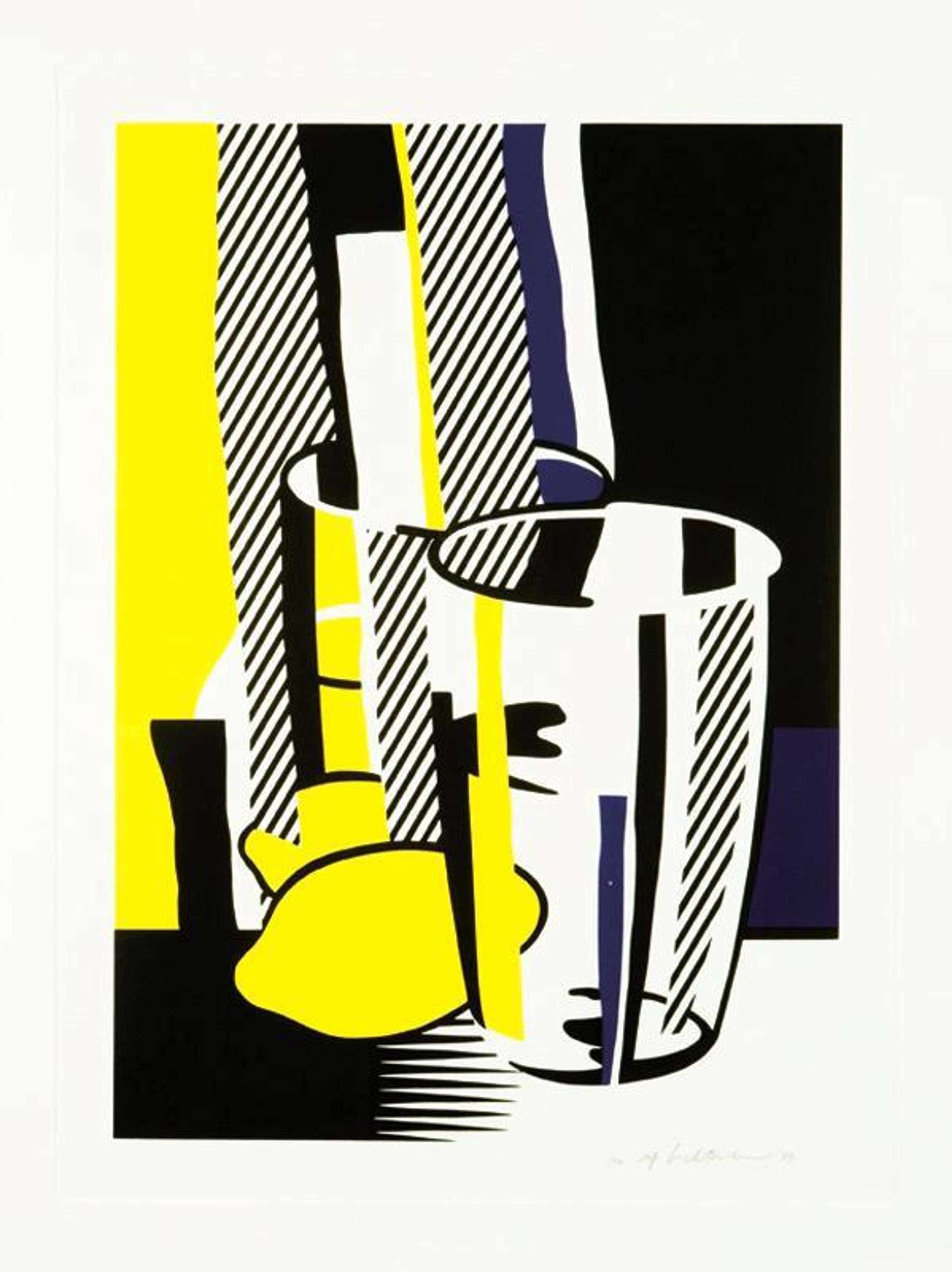 Mirror #4 © Roy Lichtenstein 1972
Mirror #4 © Roy Lichtenstein 1972
Interested in buying or selling
Roy Lichtenstein?

Roy Lichtenstein
290 works
In his Mirrors series, Roy Lichtenstein faced one of the biggest challenges an artist can face: capturing light. Through his formal representation of mirrors, and reluctance to convey the reflections within them, Lichtenstein's body of work was one of his most abstract to date.
Lichtenstein subverts the purpose of the mirror.
 Mirrors #6 © Roy Lichtenstein 1972
Mirrors #6 © Roy Lichtenstein 1972Typically, the mirror is an object used purely to reflect its surroundings or beholder. However, Lichtenstein's Mirrors are purposefully two-dimensional, reflecting nothing, and formed of flat blocks of colour and dots.
Lichtenstein focuses solely on the form of his mirrors.
 Mirror #5 © Roy Lichtenstein 1972
Mirror #5 © Roy Lichtenstein 1972Lichtenstein's Mirrors are characterised by simple blocks of colour and dots. The artist uses geometric forms to mimic light hitting the surface of the mirrors, but never shows the reflection that this play of light creates.
The series reveals the influence of popular print culture on Lichtenstein.
 Mirror #8 © Roy Lichtenstein 1972
Mirror #8 © Roy Lichtenstein 1972With his signature use of Ben-Day dots, block colours and graphic lines, Lichtenstein reveals the clear influence of contemporary print culture on his work. Despite his newly abstract approach, the characteristically Pop aesthetic of his earlier work is very much present in this later series.
Lichtenstein's Mirrors parody Art Deco.
 Mirror © Roy Lichtenstein 1990
Mirror © Roy Lichtenstein 1990In their decorative flatness, Lichtenstein's Mirrors mock the aesthetic of Art Deco. By reducing his Mirrors even further, sometimes to a few lines, Lichtenstein pronounces the lifelessness of certain designs.
Mirrors have as long-standing place in art history.
 Mirror #3 © Roy Lichtenstein 1972
Mirror #3 © Roy Lichtenstein 1972Throughout the history of art, mirrors have been consistently painted to prove the talent of the artist, creating pictures within pictures. The representation of mirrors in painting has also been a common motif to prove the worthiness of painting, in comparison with the arts of sculpture and - more recently - photography. Lichtenstein, on the other hand, had no desire to cleverly represent the reflection in his Mirrors, and worked to capture their basic form instead.
Lichtenstein was continually inspired by objects and design.
 Before The Mirror © Roy Lichtenstein 1975
Before The Mirror © Roy Lichtenstein 1975As his artistic career progressed, Lichtenstein became increasingly fascinated by design. His Entablature series, for example, reveals a similar preoccupation with recognisable design, objects, and motifs.
The series was inspired by advertisements.
 Mirror #4 © Roy Lichtenstein
Mirror #4 © Roy Lichtenstein Lichtenstein's oeuvre, in its entirety, is based on imagery from popular culture. As his earlier works reveal, Lichtenstein was always inspired by popular comic books and advertisement imagery. Allegedly, the mirrors that form the basis of this series were informed by mirrors that Lichtenstein had seen in sales catalogues.
Lichtenstein's Mirrors have been regarded as "total abstractions".
 Twin Mirrors © Roy Lichtenstein 1970
Twin Mirrors © Roy Lichtenstein 1970As Elizabeth Baker reported in ArtNews in 1971, Lichtensteins Mirrors "are close to being total abstractions ... They are, in effect, elaborately composed pictures of reflections of air." Through his reluctance to represent anything reflected in his Mirrors, Lichtenstein therefore presented the formal properties of the mirror and abstracted them to almost undecipherable forms.
Lichtenstein has a unique approach to capturing light.
 Mirror #7 © Roy Lichtenstein 1972
Mirror #7 © Roy Lichtenstein 1972The Mirrors series is an instance in which Lichtenstein attempted to capture something completely intangible: light. Though this might have seemed like a daunting task for most Pop Artists, Lichtenstein used his iconic dots and graphic style to mimic the movement of light across the surface of his Mirrors.
The series is a perfect encapsulation of Pop Art's merging of 'high' and 'low' culture.
 Mirror © Roy Lichtenstein 1972
Mirror © Roy Lichtenstein 1972The series was executed with Lichtenstein's archetypal industrial printing process, treating his artwork like images intended for mass media, or 'low' visual culture. However, the series still reveals the influence of artistic tradition because of Lichtenstein's choice of subject matter.
